5.1 Viewing Software Inventory
Software inventory is collected once a day from the handheld device. Software inventory data is displayed in the ZENworks Handheld Management Inventory Viewer.
ZENworks Handheld Management lets you collect and view software inventory information for Palm OS, Windows CE (including Pocket PCs), and BlackBerry devices.
To view software inventory:
-
In ConsoleOne, right-click a handheld device object, click , then click .
-
Click the tab.
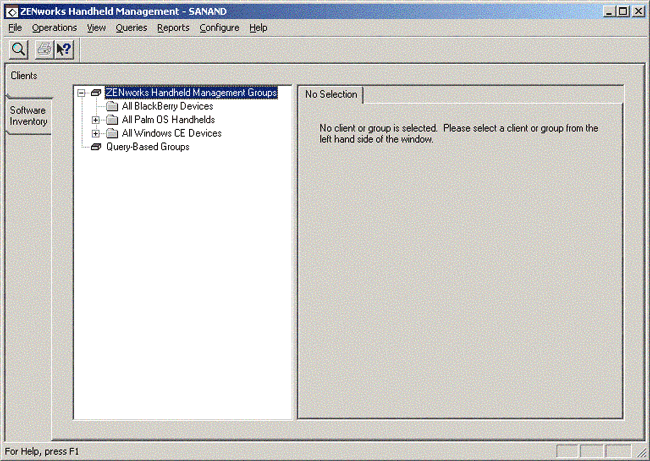
The Software Inventory list in the left frame contains directories named Palm Applications, BlackBerry Applications, and Windows CE Applications. You can expand these directories to display a list of all the applications found on all handheld devices in your system.
If ZENworks Handheld Management cannot identify an application on a Windows CE device, the application is listed in the Unidentified Windows CE Files tree in the Software Inventory list in the left frame.
The right frame contains a column that lists each application in alphabetical order by company name and a column that lists each application’s version number.
NOTE:For BlackBerry devices, ZENworks Handheld Management collects software inventory only for applications that display on the device’s > screen.
The following sections contain additional information:
5.1.1 Viewing Software Inventory for a Specific Handheld Device
ZENworks Handheld Management lets you view the applications installed on a specific Palm OS, BlackBerry, or Windows CE handheld device. You can also view application details about a specific application on any handheld device in your system.
To view software inventory for a specific device:
-
In ConsoleOne, right-click any handheld device object, click , then click to open the ZENworks Handheld Management Inventory Viewer.
-
Click the tab, then expand the ZENworks Handheld Management Groups directory.
-
Expand the desired platform directory in the tree: , , or .
-
Click the handheld device whose software applications you want to view.
-
Click the tab in the right pane.
Depending on which platform you chose in Step 3, the information displayed in the SW Inventory page varies.
Palm OS Devices: Lists the application name, version, creator ID, and whether the application is installed in ROM, RAM, or on a storage card.
BlackBerry Devices: Lists the application name and version.
Windows CE Devices: Lists the name of the company that created the application, the application name, and the version.
NOTE:You can determine when the last inventory scan was performed by looking at the Last Software Inventory information at the bottom of the dialog box.
-
To view details about a specific application, double-click the application.
The View Application Details dialog box displays the application’s size, creation date, backup date, and more.
5.1.2 Viewing Software Inventory Across All Palm OS, BlackBerry, or Windows CE Devices in Your System
ZENworks Handheld Management lets you view software inventory information across all of the Palm OS, BlackBerry, or Windows CE devices in your system. Suppose, for example, that you want to ensure licensing compliance for a certain application. ZENworks Handheld Management helps you determine how many copies of that application users have installed on individual devices in your organization. You can also display a list containing the name of each device that has the application installed.
To view software inventory information for all Palm OS, BlackBerry, or Windows CE devices in your system:
-
In ConsoleOne, right-click any handheld device object, click , then click to open the ZENworks Handheld Management Inventory Viewer.
-
Click the tab on the left side of the dialog box, then expand the desired platform folder in the tree: , , or .
If you expand the folder, you also need to expand the company folder.
-
Click the application whose details you want to view.
-
Click the tab to view the application’s details, which vary depending on the platform.
Palm OS Applications: Lists the application’s name, the version, the Creator ID, the icon name, and how many installations of the application exist on the Palm OS devices in your system.
BlackBerry Applications: Lists the application’s name and its version, and the total number of copies installed.
Windows CE Applications: Lists the application’s name, version, company name, the files that make up the application, and the total number of copies installed.
-
Click the tab in the right frame to view all the handheld devices in your system that have the selected application installed and to list additional details, depending on the platform.
Palm OS Devices: Lists information about the individual devices that the selected application is installed on, including the name of the device, where the application is installed (RAM, ROM, or on a Storage Card), the application’s size, create date, modify date, and record count.
BlackBerry Devices: Lists information about the individual devices that the selected application is installed on, including the name of the device, the application’s size, and more.
Windows CE Devices: Lists information about the individual devices that the selected application is installed on, including the name of the device, the last time the application was scanned, and the installation path on those devices.
For Windows CE applications, you can also view file details if you want to know details about a specific file that is part of an application (for example, to determine the version of a specific executable file you are running).
-
Click the tab in the left frame.
-
Click the tab in the right frame.
-
Double-click the application file in the list box.
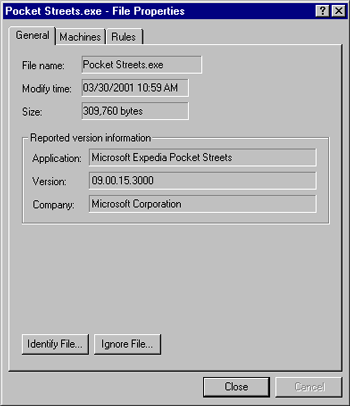
The File Properties dialog box provides a quick snapshot of information about the file.
Click the following tabs to view information about the selected file:
-
General: Lists all application version information, including filename, modify time, and file size.
-
Clients: Lists the Windows CE devices that the file is installed on.
-
Rules: Lists the Identification and Ignore rules created for the file. For more information, see Viewing Windows CE Identified and Ignored File Rules.
-
5.1.3 Identifying Files for Windows CE Devices
If a Windows CE application file does not have any product information associated with it, ZENworks Handheld Management considers it “unidentified” and stores it in the Unidentified Windows CE Files folder.
There may be some unidentified files that you want ZENworks Handheld Management to recognize as valid applications whenever ZENworks Handheld Management finds the files on a device. For these files, ZENworks Handheld Management allows you to specify the product, company, and version information so that the files are identified as applications.
When you identify files, an identification rule is created for the files. After they are identified, the files appear in the Windows CE Applications folder (with a list of the devices it is found on). The files are then removed from the list of unidentified files.
To make an unidentified file a known application:
-
In ConsoleOne, right-click a handheld device object, click , then click .
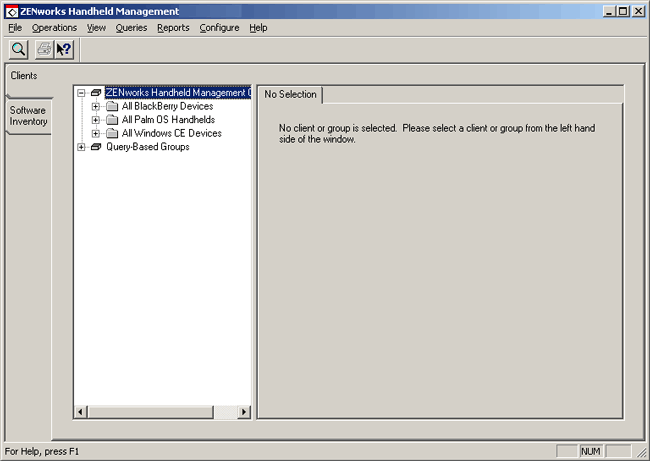
-
Click the tab, then click the icon (the question mark).
A list of unidentified files displays in the right pane.
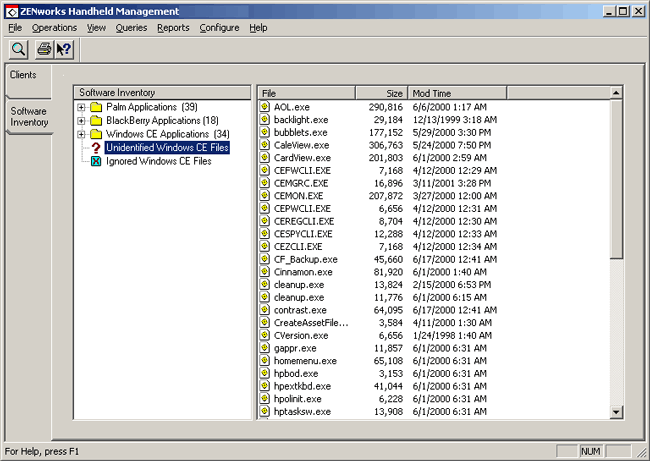
-
Double-click the file you want to identify, then click .
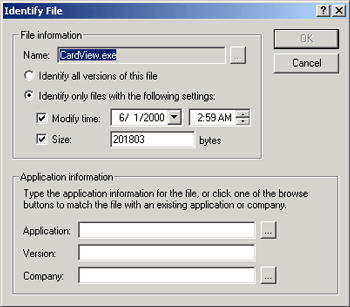
-
Specify the name of the application you want this file to identify with, the version, and the company name.
If desired, change the modify time and size for the identification rule.
If you specify a different size and/or date, only files matching those exact specifications are identified as a known application. Versions of the file not matching the criteria still appears as unidentified.
-
Click .
The file now appears as an application in the Windows CE Applications folder in the tree.
5.1.4 Ignoring or Identifying Windows CE Files and Applications
ZENworks Handheld Management by default ignores some Windows CE application files so the application view remains manageable. Ignored files appear in the Ignored Windows CE Files folder in the Software Inventory page and in the tab in the Clients page.
The following sections contain additional information:
Ignoring Windows CE Files
To keep your list of unidentified files more manageable, you can ignore unidentified files that you are not going to identify as applications.
Ignoring these files keeps your unidentified files list smaller, which might help you to recognize when ZENworks Handheld Management encounters new unidentified files during software inventory.
To ignore unidentified files:
-
In ConsoleOne, right-click a handheld device object, click , then click .

-
Click the tab, then click the icon (the question mark).
-
Double-click the file in the right pane.
-
Click .
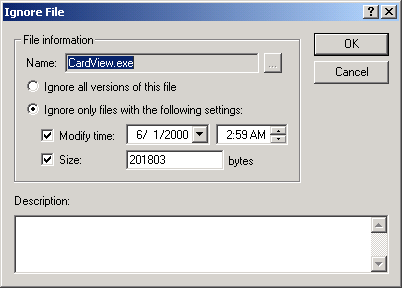
-
Select .
or
Select, then specify the modify time and size settings as appropriate.
-
If desired, type a description of why you are ignoring the file.
-
Click .
The file appears in the Ignored Windows CE Files tree view.
Ignoring Windows CE Applications
To keep your Applications folder manageable, you can ignore applications. This allows you to view only the applications that you think are important to display.
For example, you might want to ignore any applications that are by default included with the operating systems (for example, Microsoft Clock).
To ignore an application:
-
In ConsoleOne, right-click a handheld device object, click , then click .

-
Click the tab, then click the application you want to ignore.
NOTE:You can ignore Windows CE applications only; you cannot ignore Palm OS and BlackBerry applications.
-
Click , then click .
The Ignore Application dialog box lists files that are ignored.
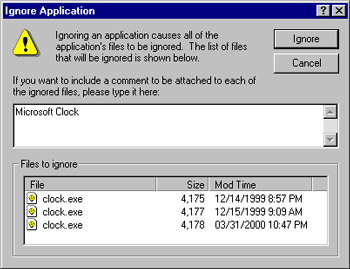
-
If desired, type a description of why you are ignoring the files.
The description is stored with the file and can be viewed with the rule created for the file. For more information, see Viewing Windows CE Identified and Ignored File Rules.
-
Click .
The application files are stored as Ignored files. Any files that future software inventory collections find that match the criteria you specified are also stored as Ignored files.
NOTE:Ignoring applications ignores files that are currently known that identify themselves with the ignored application. If new files appear that identify themselves as this application, the application reappears in the Applications view.
Identifying Ignored Windows CE Files
You can identify ignored application files that you want to be recognized as applications.
To identify ignored files:
-
In ConsoleOne, right-click a handheld device object, click , then click .

-
Click the tab, then click the icon.
-
Double-click the file you want to identify, then click .
-
Specify the name of the application you want this file to identify with, the version, and the company name.
-
If desired, change the modify time and size for the identification rule.
If you specify a different size and/or date, only files matching those exact specifications are identified as a known application. Versions of the file not matching the criteria still appear as unidentified.
-
Click .
Viewing Windows CE Identified and Ignored File Rules
When you identify or ignore a Windows CE file or application, a rule is created for the file.
You can view all the rules you have created by clicking > in the ZENworks Handheld Management Inventory Viewer.
A rule applies to a file name, not to versions, so you might see rules even if you did not create the rule for a specific version of a file you are viewing. Another rule could have been created for a file that had a different time stamp or size but the same name.
When you identify or ignore all versions of a file, the size and modify time fields display Any. When you identify or ignore a specific version of a file, the size and modify time fields match the file you have created the rule for.
If you attempt to create a rule for a file that matches an existing rule, you are warned before overwriting the existing rule. The same thing happens if you try to create an ignore rule for a file that already has an identification rule.
To view all rules an administrator has created in ZENworks Handheld Management:
-
In ConsoleOne, right-click a handheld device object, click , then click .
-
Click , then click .
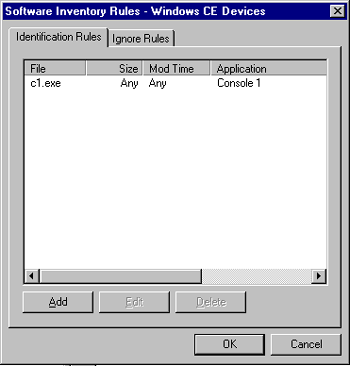
The Software Inventory Rules dialog box lists any files you have identified or ignored.
You can change any rule by selecting the rule, then clicking . You can also identify or ignore a file by clicking , then creating the rule. You can even create a rule for files that have not been installed on your devices yet.
To view rules for a specific file:
-
In ConsoleOne, right-click a handheld device object, click , then click .
-
Double-click an unidentified or ignored file.
-
Click the tab.
All user-defined ignore and identification rules that match the name of the file appear.